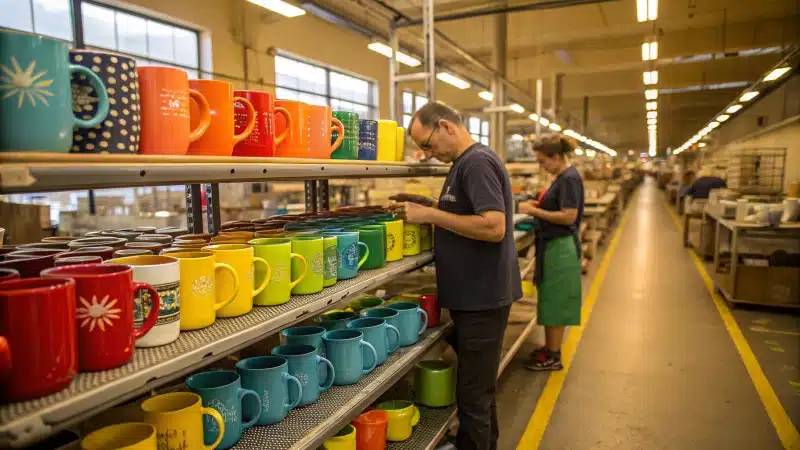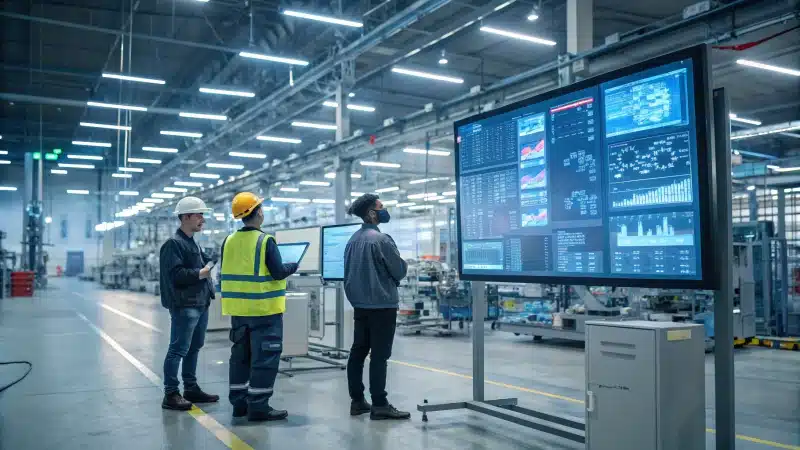
Navigating the world of custom mug orders can be a daunting task, but with the right approach, it’s entirely manageable.
To achieve consistency in custom mug orders from factories, ensure clear communication of design specifications, request samples before large orders, implement a robust quality control process, and provide accurate demand forecasts. These practices help maintain uniformity and meet quality standards consistently.
While these steps provide a solid foundation for achieving consistency, there’s so much more to this journey. I remember when I first started out, the anxiety of not knowing whether the final product would match my expectations was overwhelming. But by fostering strong relationships with suppliers and learning from each experience, I managed to find a rhythm. Dive deeper into these strategies, and you’ll not only streamline operations but also uphold your brand’s cherished standards. It’s a rewarding path that leads to lasting success in the world of custom ceramics.
Clear design specs ensure consistent mug orders.True
Clear specifications help factories understand and replicate designs accurately.
Demand forecasts are unnecessary for mug order consistency.False
Accurate demand forecasts help factories prepare and maintain order uniformity.
How Does Communication Ensure Consistency?
Ever found yourself tangled in a web of misunderstandings due to poor communication? I have, and it taught me the invaluable role communication plays in maintaining consistency.
Communication ensures consistency by establishing clear expectations, providing regular updates, and enabling feedback. This helps align efforts, reduce errors, and maintain quality standards across all processes involved in a project or operation.

Establishing Clear Expectations
In my experience, the cornerstone of achieving consistency is setting clear expectations from the get-go. When I started out in ceramic manufacturing, I learned this the hard way. I once had a batch of mugs that didn’t meet the quality standards simply because the specifications were vaguely communicated. Since then, I’ve made it a point to detail everything—from specifications to quality standards1—so everyone understands their role and our end goals.
Providing Regular Updates
You know, keeping everyone in the loop is like oiling a machine—it keeps everything running smoothly. Whether it’s a quick meeting or a digital update, I’ve seen how regular communication about changes or progress can prevent surprises and maintain harmony2 across teams. It’s something I prioritize to ensure we’re all on the same page.
Enabling Feedback Mechanisms
The feedback loops are my secret sauce for continuous improvement. They offer a chance for real-time adjustments based on frontline experiences, something I’ve encouraged since day one. By fostering open dialogue, I’ve been able to capture insights that have significantly enhanced our consistency.
| Communication Aspect | Benefit to Consistency |
|---|---|
| Clear Expectations | Reduces Misunderstandings |
| Regular Updates | Keeps Everyone Aligned |
| Feedback Mechanisms | Allows Real-time Adjustments |
Aligning Efforts Across Teams
I’ve noticed that when communication is seamless, teams naturally align towards common objectives. Sharing insights and challenges isn’t just beneficial—it’s essential for synchronizing efforts and boosting overall efficiency3.
Reducing Errors Through Clarity
Miscommunication can be a real pain point, often leading to costly errors. I’ve learned that by cultivating a culture of clarity—using precise language and confirming understanding—we can cut down on these errors significantly.
Maintaining Quality Standards
At the heart of upholding quality standards is effective communication. It’s all about conveying detailed specifications and expectations to every stakeholder. Ensuring that everyone knows what’s required has been key in consistently maintaining our high standards.
Clear expectations reduce misunderstandings.True
Setting clear expectations helps everyone understand their roles and goals.
Regular updates create confusion among teams.False
Regular updates keep everyone aligned and minimize surprises.
How Can Quality Control Processes Be Improved for Custom Orders?
Ever struggled with maintaining quality in custom orders? You’re not alone. Let’s dive into how refining quality control can make all the difference.
Improving quality control for custom orders involves establishing clear communication, utilizing advanced inspection techniques, implementing feedback loops, and leveraging technology for real-time monitoring. These strategies ensure consistent quality and customer satisfaction.

Establish Clear Communication Channels
I remember when I first started out with MTCeramic, one of our biggest challenges was ensuring that every custom order met the client’s unique expectations. It was all about communication. I learned the hard way that open and regular dialogue with both suppliers and clients is absolutely essential. We developed a comprehensive quality checklist4 that included everything from design specifications to material standards and inspection criteria.
Utilize Advanced Inspection Techniques
The introduction of advanced inspection techniques like 3D scanning has been a game-changer for us. I recall this one time when a particularly complex design came through, and I was worried about maintaining its intricate details. With 3D scanning, we achieved high precision measurements that minimized human error. Automated visual inspection systems helped us catch defects early, making the process much more efficient.
| Technique | Benefits |
|---|---|
| 3D Scanning | High precision measurements |
| Visual Inspection | Automated defect detection |
Implement Feedback Loops
I’ve found that establishing feedback loops between our production team and the quality assurance department fosters a culture of continuous improvement. After completing a batch of custom orders, we routinely review what went well and what could be improved. It’s enlightening to see how small tweaks can make such a big difference in meeting customer expectations.
Leverage Technology for Real-Time Monitoring
Implementing IoT-enabled devices and smart sensors has enabled us to track production conditions in real-time. I set up a dashboard displaying key metrics like defect rates and lead times, which has been instrumental in making swift decisions. This proactive approach allows us to maintain consistency and respond promptly to any issues that arise.
Explore Industry Standards5
Familiarizing myself with industry standards has provided invaluable insights into best practices for maintaining quality. These benchmarks have guided us in developing internal protocols that align with industry expectations.
By integrating these strategies, businesses like mine can significantly enhance their quality control processes, ensuring each custom order is produced to the highest standards while meeting the unique requirements of our clients.
3D scanning reduces human error in quality control.True
3D scanning provides precise measurements, minimizing human error.
Feedback loops delay the quality control process.False
Feedback loops promote continuous improvement, not delays.
Why Are Samples Important Before Large-Scale Production?
Imagine launching a new product only to find it doesn’t meet expectations—what a nightmare!
Samples are essential before large-scale production because they provide a tangible reference for quality, design, and functionality, minimizing risks and ensuring that the final product meets expectations.

Ensuring Quality and Consistency
You know, when I first started in ceramics, I learned the hard way how crucial it is to keep quality standards6 in check. That’s where samples come in—they’re like your safety net. They give you a clear picture of what the end product should be, helping you catch any issues before they snowball. With samples, I can:
- Spot design flaws.
- Ensure materials are just right.
- Validate the production process without leaving anything to chance.
Minimizing Financial Risks
There was this one time I skipped the sample phase, thinking I was saving money. Boy, was I wrong! I ended up with a batch of mugs that were completely off-spec. It taught me that investing in samples can actually save you money in the long run by avoiding costly mistakes. Evaluating samples lets you:
- Confirm specifications and avoid waste.
- Ensure cost-effectiveness in material selection.
Aligning with Market Needs
I always say, "Listen to your market," and samples are a great way to do just that. They allow me to test the waters and get feedback before diving into full production. This feedback is invaluable—it helps me:
- Tweak designs to better meet customer preferences.
- Refine my products based on real-world reactions.
Facilitating Communication with Suppliers
Clear communication with suppliers can sometimes feel like a game of telephone—something always gets lost in translation. Samples act as the universal language, helping bridge gaps and set clear expectations by:
- Highlighting potential manufacturing challenges.
- Ensuring everyone is on the same page through language barriers7.
| Benefits of Sampling | Description |
|---|---|
| Quality Assurance | Verifies design and functionality. |
| Cost Management | Prevents financial loss from defects. |
| Market Testing | Aligns product with consumer demands. |
| Supplier Coordination | Enhances communication and understanding. |
By focusing on these key areas, I can confidently mitigate risks associated with large-scale production and streamline the supply chain. Effective sampling8 ensures that the final product meets both my company’s standards and our customers’ expectations.
Samples prevent costly errors in production.True
Samples identify issues early, saving money by avoiding large-scale mistakes.
Skipping samples guarantees market success.False
Without samples, products may not align with market needs, risking failure.
How Do Demand Forecasts Help in Planning Production Efficiently?
Ever wondered how you can run a smoother production line without the constant worry of overstock or shortages?
Demand forecasts provide valuable insights into expected customer needs, enabling manufacturers to schedule production efficiently, allocate resources effectively, and minimize operational costs by reducing overproduction and stockouts.

Enhancing Production Scheduling
I remember the first time I realized the importance of demand forecasting. It was during a hectic season when we were scrambling to meet orders, yet our warehouse was packed with items that weren’t selling as expected. By accurately predicting future demand, I learned we could align our production schedules with market needs9. This not only utilized our capacity optimally but also helped us avoid those dreaded idle times and costly rush orders. A well-tuned production line has led to significant cost savings for us over the years.
Effective Resource Allocation
Imagine being able to look into the future and know exactly how much labor and raw materials you’ll need. That’s the magic of demand forecasting. For instance, during peak demand periods, we ramp up production, ensuring we don’t overextend resources. This strategy not only minimizes wastage but also maximizes productivity.
| Resource | Peak Demand Strategy | Off-Peak Strategy |
|---|---|---|
| Labor | Increase shifts | Reduce overtime |
| Materials | Bulk purchase | Minimize stocks |
Minimizing Operational Costs
Accurate forecasts have been our secret weapon in maintaining optimal inventory levels. They help us cut storage costs and avoid the risk of stockouts. By aligning production with demand, we’ve managed to reduce holding costs significantly. This balance is crucial for maintaining operational efficiency10.
Improving Supplier Relationships
Sharing our demand forecasts with suppliers has transformed our relationships. It allows them to plan their schedules accordingly, ensuring timely delivery of materials. This collaboration has led to a more resilient supply chain, capable of adapting to changes in demand. For example, when we at MTCeramic share our forecasts, it ensures a steady flow of materials like clay and glaze.
Facilitating Strategic Decision-Making
Demand forecasting isn’t just about day-to-day operations; it’s a cornerstone for strategic planning. The data helps us make informed decisions about market entry, product launches, or capacity expansion. With these insights, we’re always a step ahead, identifying emerging trends and adjusting our strategies accordingly.
To delve further into the methodologies used in demand forecasting, you might explore different forecasting techniques11 that cater to various industry needs. This includes qualitative methods like expert judgment or quantitative approaches such as time-series analysis.
Accurate demand forecasts reduce production idle times.True
By predicting demand, companies align production schedules, minimizing downtime.
Forecasts increase the risk of overextending resources.False
Forecasts help allocate resources efficiently, preventing overextension during peak periods.
Conclusion
Achieve consistency in custom mug orders by ensuring clear communication, requesting samples, implementing quality control, and providing accurate demand forecasts to streamline production and maintain standards.
-
This link explores why setting clear expectations is essential in manufacturing and how it enhances consistency. ↩
-
Discover how regular updates keep projects on track and improve team alignment. ↩
-
Learn how effective communication strategies enhance team efficiency and goal alignment. ↩
-
Provides templates and guidelines to create an effective quality control checklist tailored for manufacturing. ↩
-
Explores widely recognized standards that guide quality control practices in various industries. ↩
-
Understanding quality standards helps ensure consistency and reliability in production processes, reducing errors and improving customer satisfaction. ↩
-
Overcoming language barriers is crucial for effective communication in global supply chains, ensuring smooth transactions and successful partnerships. ↩
-
Exploring effective sampling techniques can enhance product development by providing reliable insights into design and functionality. ↩
-
Understanding market needs ensures production schedules are aligned with consumer demand, improving efficiency. ↩
-
Efficient inventory management reduces costs and enhances operational efficiency by minimizing excess stock and avoiding stockouts. ↩
-
Exploring various forecasting techniques helps in choosing the right method to accurately predict future demand trends. ↩